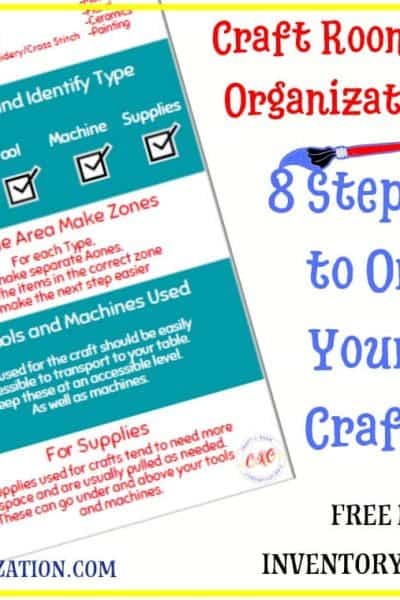Are you a crafter that uses potentially harmful chemicals, paints, solvents, etc.? Do you know the correct way to dispose of these elements? Better yet, how to ventilate your room for your health? Read on to learn about Craft Room Ventilation and other Safety Precautions.
This can be a very important step in Crafting that often goes unattended to. That is why this post about Crafts that require ventilation is so important. Please Read. You might not even realize what you are being exposed to.
There is a lot of information in this post and it is very important so please read it all! For your convenience I have created a checklist that goes along with this post so you can print it and have it handy for shopping for your craft room.

-
Save
According to the U. S. Consumer Product Safety Commission Art and Craft Safety Guide, you need to be aware of these important facts when designing your Craft Room:
1. Ensure appropriate ventilation.
- The mouth, nose, and skin can absorb hazardous materials. Ensure ventilation provides fresh air activity (see The Inside Story: A Guide to Indoor Air Quality http://www.cpsc.gov/cpscpub/pubs/450.html ) to decrease exposures to dusts, fumes, gases, mists, and vapors. Adequate ventilation means that clean air is flowing toward the artist and contaminated air is flowing away. Blowing air around with a fan without a source of clean air is not adequate ventilation, and can actually increase exposures to harmful substances.
- Prevent the accumulation of flammable vapors or spray mists to limit fire hazards with proper ventilation.
2. Have proper protective gear and cleaning supplies available.
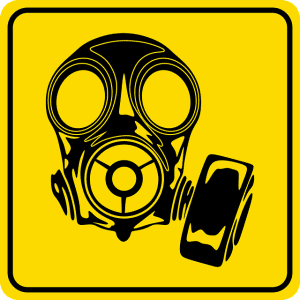
-
Save
- Wear special work clothes and keep separate from other clothing, even during clothes washing.
- Keep cleaning supplies accessible. Clean up spills immediately, even small spills, and dispose of waste chemical and cleanup materials properly.
- Contain flammable spills with activated charcoal, diatomaceous earth, or deodorant-free cat litter.
- Workplace employees must follow the EPA’s Resource Conservation and Recovery Act (RCRA) and any other applicable local regulations for spill control, containment, and disposal.
- In the event of an accidental exposure call the National Poison Control Center Hotline, 1-800-222-1222, or the number for the nearest certified Poison Control Center.
3. Wash hands and other exposed body parts after working, and before eating or using the bathroom.
- Avoid using toluene, turpentine, kerosene, or other solvents to clean your skin.
- Use soap and water or baby oil or a skin cleanser.
- Wash under fingernails. Keep nails trim and do not bite nails.
4. Maintain your health and fitness.
- Recognize your physical, emotional, and mental limits. Alertness decreases with hunger and fatigue. Anger, sadness, hurrying and frustration increase chances of accidents and mistakes.
- Have regular health check-ups.
- Make sure your health care provider is familiar with the art and craft materials you use, your level of exposure, and your studio environment.
5. Fire Safety Have fire protection devices, extinguishers, and alarms.
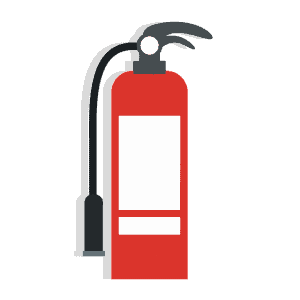
-
Save
- Ensure alarms and extinguishers are in working order and approved for the materials and chemicals used and stored.
- Ensure users know fire evacuation plans for your facilities.
- Post fire safety information in clearly visible places. Work with small amounts of materials.
- Purchase and store the smallest amounts of flammable or combustible materials needed.
- Never store large amounts of flammable or combustible materials.
- Dispense small amounts of flammable or combustible materials.
6. Keep heat sources and ignition sources away from flammable materials.
- Never smoke in a studio that has flammable or combustible materials.
- To avoid spark hazard, ensure that all electrical equipment is in good repair.
- Fans in local exhaust systems require non-sparking or nonferrous blades and the motor should be explosion proof or outside the vapor pathway.
- Avoid using space heaters.
7. Store flammable materials safely.
- Store flammable or combustible solvents in fire safety cans in an OSHA-approved fireproof cabinet. Keep cabinet closed and vented if required by local codes.
- Linseed oil or solvent-soaked rags can spontaneously combust, so rags should be stored in a covered container that does not allow air in or vapors out, such as an OSHA approved container.
- Store flammable or combustible materials away from escape routes.
- Clean spills immediately and properly.
- Keep a dry chemical or carbon dioxide fire extinguisher within easy reach.
8. Storage and Precautions for Chemical Hazards Buy, use and store chemicals wisely.
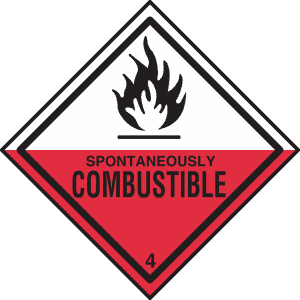
-
Save
- Read the product label. When possible, choose the safest materials available (e.g., those with few or no cautionary/warning labels).
- Familiarize yourself with the ingredients and hazards associated with the materials you use.
- Purchase volatile and other hazardous materials in small quantities.
- Ensure proper training of materials’ caretakers.
- Keep children out of studios where toxic chemicals are used.
- Ensure appropriate ventilation for this activity.
- Avoid mixing chemicals in the storage area.
- Learn local regulations and limits on storage of hazardous materials.
- Keep chemicals out of direct sunlight.
- Store toxic materials in a locked cabinet.
- Store reactive chemicals separately.
- Store hazardous chemicals in secure places away from children, but easy-to-reach to minimize falls and drops (e.g., keep large containers below shoulder height).
- Store flammable or combustible solvents in fire safety cans in an OSHA-approved fireproof cabinet. Keep cabinet closed and vented if required by local codes.
- Never store any material that you are not prepared to control if it spills.
- Avoid using food containers for storage.
- Keep containers tightly closed to prevent dust or vapor from escaping.
- Use smaller dispensers for small amounts of solvent and label them properly. • Continually clean storage and disposal facilities.
- Never remove or deface a manufacturer’s label. If it is necessary to transfer the product to another container (e.g., due to damage, lost closure, etc.), retain all the label information.
- Track the date of purchase and date of opening containers.
- Keep track of expiration dates and properly dispose of expired materials.
- Keep a current inventory of materials and properly dispose of those with a limited shelf life. Ideally, use fresh materials.
9. Have appropriate protective equipment and cleaning supplies available.
- Have cleaning materials for spills near the chemicals.
- If protective equipment is needed, store near the materials.
- Have fire protection, extinguishers, and alarms that are in working order and approved for the chemicals stored.
- Ensure users know fire evacuation plans for your studio. Post information in clearly visible places if you have visitors to your studio. OSHA requires workplace employees to be trained in these procedures.
- If corrosives are stored, have an accessible and functional eyewash or shower.
10. Disposal Precautions for Chemical Hazards
- Know what local regulations require for hazardous waste disposal. Employers must know state and federal regulations and maintain arrangements with hazardous waste disposal companies.
- Disposal practices in the employment setting are required to follow the Environmental Protection Agency’s (EPA) Resource Conservation and Recovery Act (RCRA) which tightly governs all garbage and industrial waste. More information is available online (www.epa.gov/rcraonline/).
- Recycle when possible, but only donate materials that conform to ASTM D-4236, and do not donate materials with cautionary/warning statements on the label to elementary schools.
- Do not pour solvents or other hazardous materials and wastes down the drain unless allowed by the sanitary sewer authorities.
- Consider recycling used solvents. If disposing, place in sealable, metal containers clearly labeled for disposal.
- Ensure spray cans are completely empty and dispose of in garbage or recycling. • Allow glues and cements to dry before disposal in garbage.
- Many localities have special programs for residential disposal of hazardous waste. Protective Equipment More explicit details about selecting appropriate protective equipment are provided by the Occupational Safety and Health Administration (OSHA) publication #3151 and the National Institute for Occupational Safety and Health’s (NIOSH) National Personal Protective Technology Laboratory (NPPTL) publications (see References at the end of this section). Employers are required to have OSHA written programs and training for protective equipment.
11. Respirators
IMPORTANT NOTE: Proper use of a respirator requires training. Hobbyists should seek an occupational clinic for advice and training. Contact your county, local, or state health department for more information. OSHA regulations require workplace employees using respirators to have medical certification, professional fit tests, and training for selecting the appropriate filters and maintenance procedures.
- Seek professional help with fitting; ensure mask fits by performing a user seal check (a test of positive and/or negative pressure) to make certain that an adequate seal is achieved (29 CFR 1910.134 App B-1).
- Ensure that the respirator you are using complies with recommendations made by the National Institute for Occupational Safety and Health (NIOSH).
- Ensure that the type of filter used will remove the chemical or dust you are working with. Some chemicals require specific cartridges (organic vapor, acidic gas, and high efficiency particulate air (HEPA). There are some chemicals for which there are no approved cartridges.
- Replace filters and cartridges regularly. Never rely on expired cartridges.
- Put respirator on before entering the work area and remove only after leaving the work area.
- Paper dust masks are not effective for chemical vapors and gases.
12. Eye Protection
IMPORTANT NOTE: OSHA regulations require employers to provide appropriate eye protection in accordance with ANSI Z87.1 standards.
- Many options for impact protection are available. Consult a reputable vendor for making an informed decision. Look for the “Z87” marking indicating compliance with ANSI Z87.1’s “Basic” impact protection standard and “Z87+” to indicate the “High” impact protection standard.
- Most prescription glasses are not an adequate substitute for real safety glasses. Goggles are available for covering over prescription glasses.
- Glasses for protecting against chemical splashes are often different from impact protection glasses. Ensure that the right glasses are used for different needs.
- Face shields are sometimes an alternative to glasses, but may require safety glasses worn beneath them if splashing can occur.
- Prevent fogging of glasses and goggles to keep vision clear.
- For ultraviolet radiation (UV) and infrared (IR) protection, select an appropriate degree of filtering.
13. Gloves
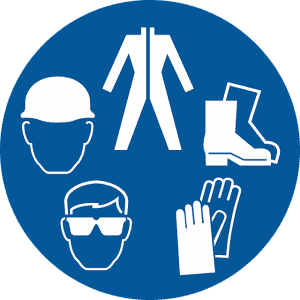
-
Save
- Chemical protection is extremely complicated. Do not judge a glove’s effectiveness by how waterproof it appears: solvents and other chemicals can pass through glove materials that water would not penetrate. This is called “permeation.” Consult the glove manufacturer’s “permeation charts” to identify the gloves that will withstand the materials you use.
- After selecting appropriate gloves for the chemicals in use, monitor the glove’s effectiveness while in use and replace worn, ripped, or permeated gloves.
- Use metal-mesh or Kevlar gloves when using sharp tools or knives.
- Use insulated gloves to protect hands from thermal burns.
- Use fabric or leather gloves when exerting high pressures or performing repetitive actions to protect from blisters.
14. Hearing Protection
- Avoid loud noises for long times or frequently repeated loud sounds.
- Power machines (e.g., compressors, pug mills) may produce sound levels that can be damaging to the ears.
- Pliable earplugs can be used for noise levels up to 120 dB.
- Do not share earplugs.
- Earmuffs provide more protection than ear plugs, up to 135 dB. Combine with earplugs for maximum protection.
15. Clothing and accessories
- Proper work clothes can greatly reduce exposures.
- Hair restraining caps or bands are recommended when using machines or chemicals.
- Remove jewelry (e.g., rings, necklaces) that can get caught in machines.
- Avoid loose clothing that can get caught in machines or catch fire.
- Hard hats are recommended for protection from falling objects.
- Safety shoes or boots protect against liquids, heat, falling objects, sparks, electric shock and sharp objects.
16. Warning Signs
The following warning slogans are designed to help reduce chemical exposures or mechanical injuries by attracting attention to the basics of art and craft safety. They may be reproduced, where appropriate, for use in any studio or classroom.
- “If you can’t do it safely, then you can’t do it.”
- “Hurrying hurts.”
- “Absolutely no food in this area.”
- “Step 1-Be careful. Step 2-Be careful. Step 3-Be careful.”
- “Creative urges should not overcome your careful urges.”
- “Limit exposure to this material.”
- “No art is worth sacrificing your health.”
In case you missed that last part: NO ART IS WORTH SACRIFICING YOUR HEALTH.
Check out the other posts in the series:
Series One: The Art of Color Theory, Color Psychology and Color Choices
Series Two: Prepping and Painting your Room
Series Three: Choosing your furniture, shelving and lighting
Series Four: Craft Room Organization and Storage Ideas
Series Five: Special consideration for Crafts that require ventilation
Series Six: Organizing your Space
Series Seven: The Art of Keeping a Clean Craft Room
BONUS: Selling your Crafts Online
Are you prepared for your safety? What crafting do you do that you might need to follow some guidelines for safety?


